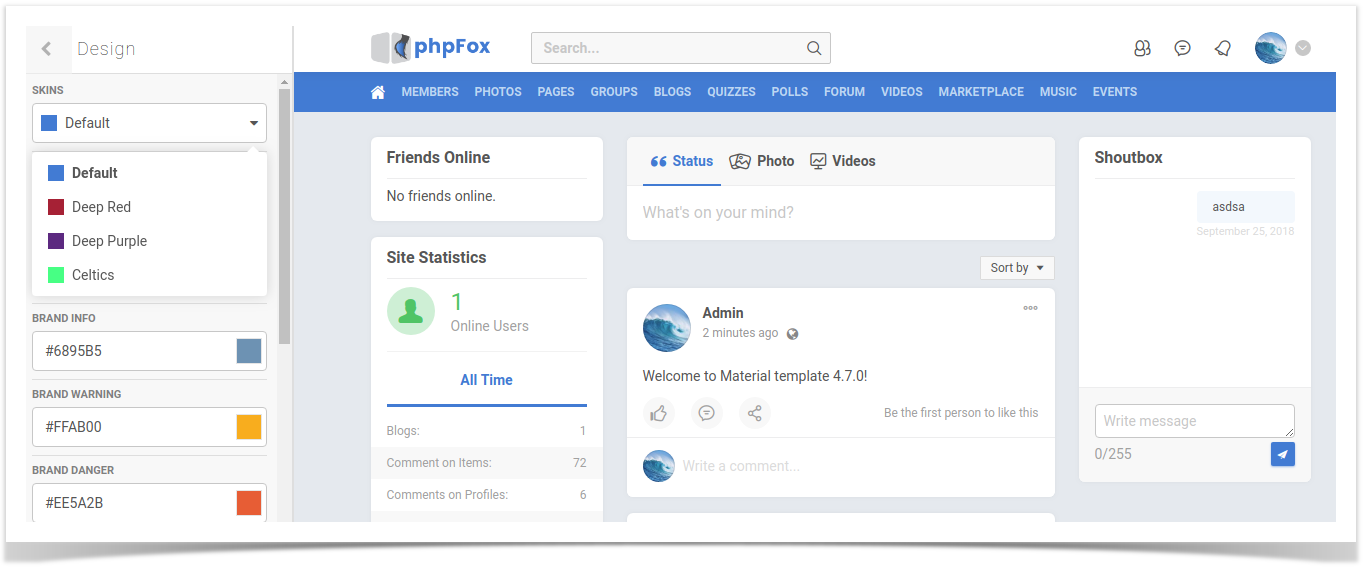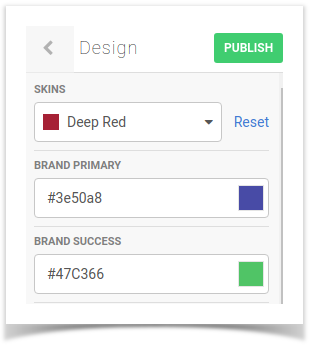As a new feature on phpFox 4.7.0, template developers now can design multiple skins for template with Template Skin feature.
Skins are sets of pre-defined color set for a certain template. Upon selecting, the color styles will be automatically applied without the need of adjusting color for each template component manually.
In this guide we will go over on how to create a skin for your template by using Material template as an example.
In source code of Material template, we begin with theme.json. We notice that there is a new variable skin in vars section.
theme.json
{
...
"vars": {
"skin": { // Define a skin section in Theme Management
"title": "Skins", // Define the title for skin section
"value": "default",
"options": [ // Define the options (color skins) for your template
{
"value": "default", // Define the skin set - The value here has to be unique
"label": "Default", // Define the name of the skin set
"primary": "#2681D5" // Define the primary color of the skin set
},
// Below are other skin sets with the same settings to Default skin
{
"value": "deep_red",
"label": "Deep Red",
"primary": "#ac1a2f"
},
{
"value": "deep_purple",
"label": "Deep Purple",
"primary": "#5a2d81"
},
{
"value": "celtics",
"label": "Celtics",
"primary": "#2eff85"
}
],
"type": "skin",
"id": "",
"attr": ""
},
...
You are now done with declaration the skin sets, now we will define the color styles for each template component in the sets.
Go to asset/skins, you will see there several LESS files. In this example of Material template, we have following LESS files:
Regarding these files, you might need to create manually with the file name identical to the value of the set.
Open up default.less for instance, we will see here all the color codes for each template component.
default.less
@skin: default; @brand-primary: #2681D5; @brand-success: #47C366; @brand-info: #6895B5; @brand-warning: #FFAB00; @brand-danger: #EE5A2B; @body-bg: #e5eaef; @links-color: #2681D5; @links-color-hover: #1e67aa; @header-bg: #ffffff; @content-bg: #ffffff; @nav-bg: #2681D5; @nav-link-color: #bbd8f3; @nav-link-color-hover: #ffffff; @input-bg: #FFF; @input-color: #555; @block-bg: #FFF; @block-title-color: #555; @block-border-color: #eee; @footer-bg: transparent; @footer-color: #7691a3;
You can define here the color for every component of the skin in your own taste. Now you already have skins for your template.
Management Skins with Theme Manager
From Admin CP >> Appearance >> Themes >> Select your template - Here we will work with Material template >> Edit
Theme Manager on Material template will open up, select Design. Here you will see a new section Skin with a drop down of all the available skins.
You can select your preferred skin color set from the drop down here to preview the changes. Here we select Deep Red for instance.
Select on Publish to apply the color skin set to your site.
You might notice that in the preview on the left side, some components don't change the color as in the set accordingly. This is because the preview only applies color styles on basic template components, but not on advanced components.
However, once you Publish to change skin, all the color style will be applied correctly without any issue.
1. In case you wish to change the color of a component in a pre-defined set, you can change directly by selecting a different color on on certain component as normal.
Hit Publish the color set will save the newly chosen color on that component to that skin.
2. In case you customized color on a skin and you want to revert back to the original skin style, you can select that skin.
Here with the customized skin, another Reset button is available here to revert the current color set to the original set. Select on Publish button to save changes.




